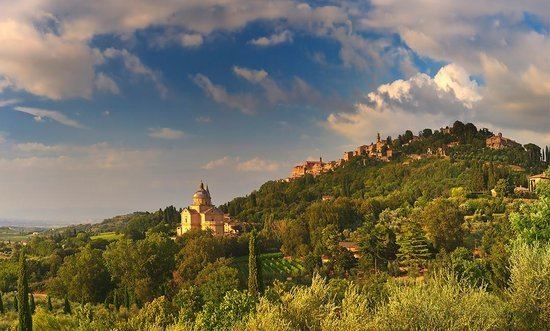Elevation 605 m (1,985 ft) Population 14,237 (2011) | ||
 | ||
Frazioni Abbadia, Acquaviva, Argiano, Ascianello, Cervognano, Fonte al Giunco, Gracciano, Montepulciano Stazione, Nottola, Salcheto, Sant'Albino, Tre Berte, Valiano Demonym(s) Poliziani or Montepulcianesi Weather 6°C, Wind S at 6 km/h, 76% Humidity Points of interest Cantina Contucci, Cantina Gattavecchi, Torre di Pulcinella, Piazza Grande, Palazzo Comunale | ||
Montepulciano ([ˌmontepulˈtʃaːno]) is a medieval and Renaissance hill town and comune in the Italian province of Siena in southern Tuscany. It sits high on a 605-metre (1,985 ft) limestone ridge, 13 kilometres (8 mi) east of Pienza, 70 kilometres (43 mi) southeast of Siena, 124 kilometres (77 mi) southeast of Florence, and 186 kilometres (116 mi) north of Rome by car.
Contents
- Map of 53045 Montepulciano Province of Siena Italy
- History
- Main sights
- People
- Twin towns Sister cities
- References
Map of 53045 Montepulciano, Province of Siena, Italy
Montepulciano is a major producer of food and drink. Renowned for its pork, cheese, "pici" pasta, lentils, and honey, it is known worldwide for its wine. Connoisseurs consider its Vino Nobile, which should not be confused with varietal wine merely made from the Montepulciano grape, among Italy's best.
History
According to legend, it was founded by the Etruscan King Lars Porsena of Chiusi; recent findings prove that a settlement was already in existence in the 4th-3rd centuries BC. In Roman times it was the seat of a garrison guarding the main roads of the area.
After the fall of the Western Roman Empire, it developed as a religious center under the Lombards. In the 12th century it was repeatedly attacked by the Republic of Siena, which the Poliziani faced with the help of the Perugia and Orvieto, and sometimes Florence, communes. The 14th century was characterized by constant struggles between the local noble families, until the Del Pecora family became rulers of the town. From 1390, Montepulciano was a loyal ally (and later possession) of Florence and, until the mid-16th century, lived a period of splendour with architects such as Antonio da Sangallo the Elder, Jacopo Barozzi da Vignola, Baldassarre Peruzzi, Ippolito Scalza and others, building luxurious residences and other edifices here. In 1559, when Siena was conquered by Florence and Montepulciano lost its strategic role, its importance declined.
After the unification of Italy and the drying of the Val di Chiana, the town remained the most important agricultural centre in the area, while the industrial activities moved mostly next to Chiusi, which was nearer to the railroad being built in that period.
A competitive "barrel race through the city" called the Bravio delle botti has been held on the last Sunday of August since the 14th Century.
Main sights
The main street of Montepulciano stretches for 1.5 kilometres (0.9 mi) from the Porta al Prato to the Piazza Grande at the top of the hill. The city is renowned for its walkable, car-free nature.
The main landmarks include:
The walls of the city date to around the 14th century.
People
Twin towns — Sister cities
Montepulciano is twinned with:
